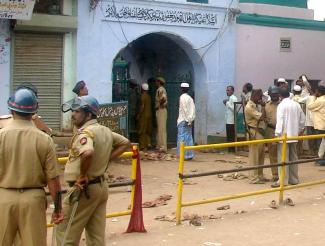Malegaon Blasts: An Update
At least 37 people were killed and over a hundred injured in two powerful bomb explosions in the communal sensitive Malegaon town, located in the Nasik district of Maharashtra, on September 08. 2006. Many of those killed and injured were minors. The explosions occurred outside the Bada Kabristan (Large cemetery), a burial ground for Muslims where people gathered to offer prayers for their dead relatives on the occasion of Shab-e-Baraat (night of salvation). The second blast took place near Noorani mosque. There was reportedly a third blast near Mushawarat Chowk, but no casualty was reported from this blast.
At the outset, the motive behind these blasts appears to create confusion and panic within both the community which could turn into a bloody pogrom. Though no terrorist groups have claimed responsibility so far, the needle of suspicion zeroing in on Pakistani-backed outfits. Maharastra Police sources had said that the blasts may have been executed by a group funded by the Lashkar-e-Toiba and there could be a Student Islamic Movement of India (SIMI) angle. In addition, the suspicion hovered around both Islamic and Hindu extremist groups like the Bajrang Dal. Around sixty suspects belonging to both Hindu and Muslim communities have been rounded for questioning. Contrary to reports that crude devices were used in the Malegaon blasts Nasik Police said the bombs were made of a deadly mixture of RDX, ammonium nitrate and petroleum, and quite identical to the bombs used in Mumbai sub-urban train blasts in July this year.
Malegaon, a predominantly Muslim textile town off the Mumbai -Agra National Highway in Nasik district, has a history of communal riots and sectarian tension between the Hindu minority and the Muslim majority populations. The city witnessed a communal riot in October 2001 in which 13 people were killed. The riot erupted when police tried to stop anti-American pamphlets distributed by a youth outside the town’s Jama Masjid. The pamphlet was an appeal to boycott American and British goods to protest against the US attack on Afghanistan. A week before protestors had carried portraits of bin Laden and shouted anti-US slogans. Immediately after the 8 September blasts, the Prime Minister of India, Dr. Manmohan Singh appealed for peace and communal harmony. The Union Home Minister, Shivraj Patil, has indicated that the Malegaon incidents had a “bigger design” to divide Indian society on communal lines. The Malegaon blasts happened only two months after a series of explosions killed more than 180 people on the railway networks of Mumbai on 11 July.
On an earlier occasion, Maharastra police recovered a huge cache of arms and explosives from this communally sensitive town. Meanwhile, Hyderabad-based Civil Liberties Monitoring Committee India (CLMC) condemning the blasts at Malegaon mosque demanded an investigation of the Hindu extremist groups. On another occasion, Jamiat-e-Ulema-e-Hind, Chief Maulana Arshad Madani demanded a probe by the Central Bureau of Investigation (CBI) into the blasts. While the Anti Terrorism Squad of Mumbai police and other intelligence agencies are probing the Malegaon blasts, a bomb scare in that town following the discovery of an unclaimed box in a shopping complex near Mohammedia Madrasa Centre and seizure of gelatin sticks along with detonators in nearby Nasik city ignited fresh fears and prompted authorities to tighten security measures around Maharastra.
